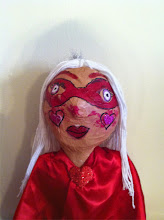Huang Yong Ping, buddha's hands, 2006
Huang Yong Ping - french artist of chinese origin is exhibiting as part of arsenale at
Venice Art Biennale 09. ping's work has its roots in confrontation, contrast, exchange,
and the coexistence of different cultural and spiritual worlds. his oversize recreations
of the hand of buddha is made from a type of cedar tree traditionally used in chinese
medicine, that dwell in the ambiguity of references to both spiritual and earthly realms.
Mixed media on paper on Aludibond on wood
The Museum of Contemporary Art, Los Angeles
Franz Ackermann’s work explores issues of travel and tourism, contrasting subjective experience with broader issues of globalization, mobility, and commerce. He travels to select locations to render time and geographic space in wall-scale paintings and mixed-media constructions. African Diamond, like many of his works, eradicates the formal boundaries between sculpture, painting, and advertising by translating each medium’s visual vocabulary into his own distinct patois.
Michal Rovner, Chinese Calculator, 2004
Steel vitrine with glass, stone and DVD video projection
Installed near the entrance of the Biennale, Israeli born, New York-based artist Michal Rovner presents Chinese Calculator (2004)four stone tablets that celebrate faux archaeological findings by establishing a fictitious history. Each rough stone slab is touched with light from tiny projectors. Small patches of light noticeably waver on their hard surfaces, refusing permanence and legibility. The projections resemble ancient script, but they are actually human figures, alive and active.
Yinka Shonibare, The Swing (reproduction of Fragonard's 'the swing'), 2001
Yinka Shonibare is someone born in England but born to Nigerian parents. Eventually moves back to Nigeria, but was also educated in England; so is truly bi-cultural, and uses this experience to confront what it's like to grow up in with Nigerian traditions but to be educated in Western culture.









No comments:
Post a Comment